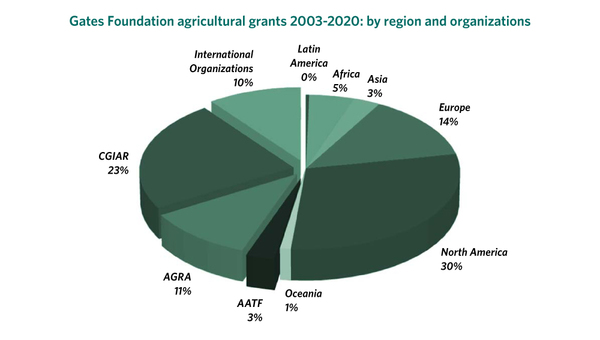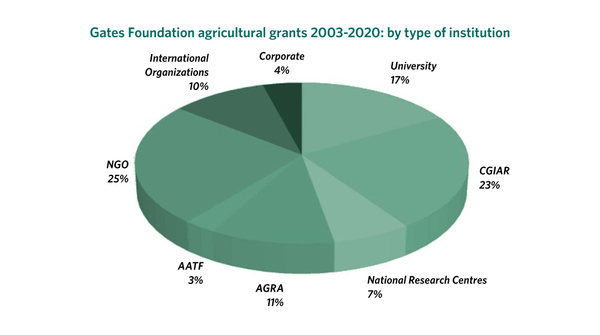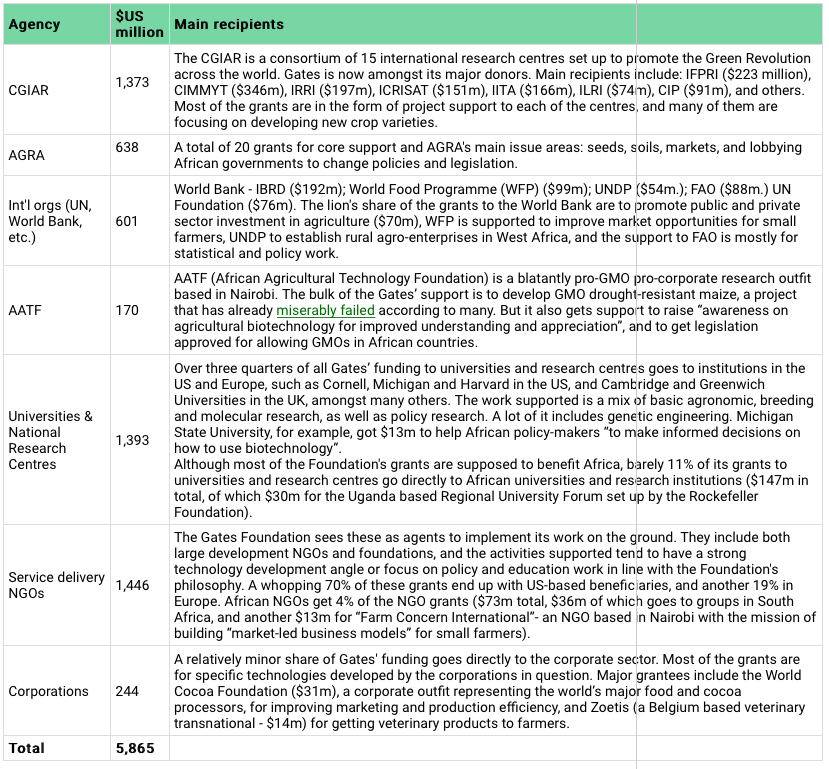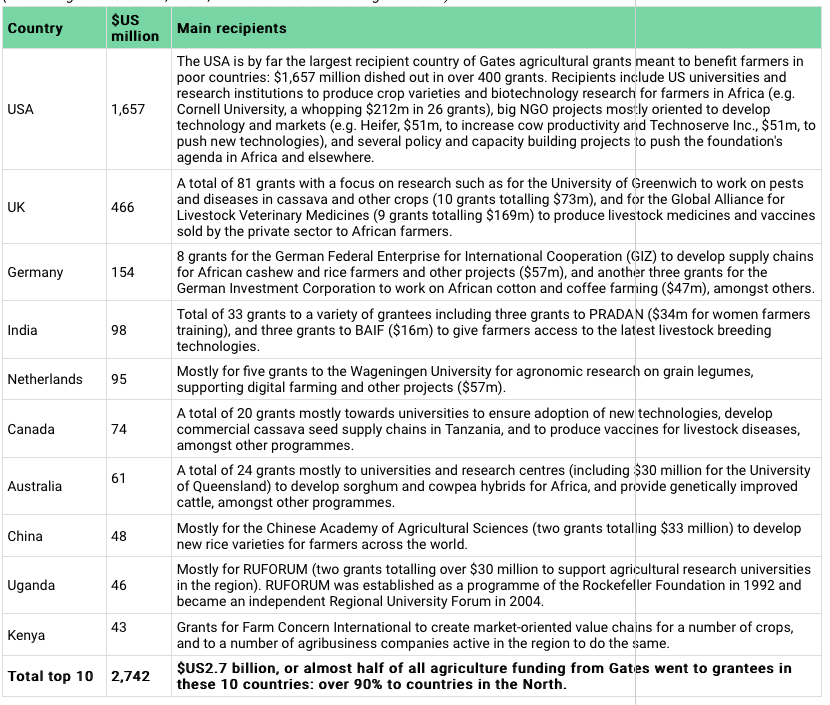“Bad for African Farmers, Bad for the Planet”: How the Gates Foundation Is Driving the Food System in the Wrong Direction
 By GRAIN
By GRAIN
The Bill and Melinda Gates Foundation has spent nearly US$6 billion over the past 17 years trying to improve agriculture, mainly in Africa. This is a lot of money for an underfunded sector, and, as such, carries great weight. To better understand how the Gates Foundation is shaping the global agriculture agenda, GRAIN analysed all the food and agriculture grants the foundation has made up until 2020.
We found that, while the Foundation’s grants focus on African farmers, the vast majority of its funding goes to groups in North America and Europe. The grants are also heavily skewed to technologies developed by research centres and corporations in the North for poor farmers in the South, completely ignoring the knowledge, technologies and biodiversity that these farmers already possess.
Also, despite the Foundation’s focus on techno-fixes, much of its grants are given to groups that lobby on behalf of industrial farming and undermine alternatives. This is bad for African farmers and bad for the planet. It is time to pull the plug on the Gates’ outsized influence over global agriculture.
In 2014 GRAIN published a detailed breakdown of the grants made by the Bill and Melinda Gates Foundation to promote agricultural development in Africa and other parts of the world.1 Our main conclusion then was that the vast majority of those grants were channelled to groups in the US and Europe, not Africa nor other parts of the global South. The funding overwhelmingly went to research institutes rather than farmers. They were also mainly directed at shaping policies to support industrial farming, not smallholders.
Widget not in any sidebars
Much has happened since then. For starters, Bill and Melinda Gates announced their divorce in May this year, leaving the future of the Foundation and its grant-making in doubt. The news came as Bill Gates himself came under fire for supporting Big Pharma’s patent monopoly on COVID-19 vaccines, for effectively preventing people’s access across much of the world, and for how he treats – or mistreats – women.2 The Foundation’s agenda with agriculture has also been coming under increased scrutiny. A 2020 report from Tufts University concluded that its work in Africa completely failed to meet the objectives that it had set itself.3 The African Centre for Biodiversity published a string of reports denouncing the Gates Foundation for pushing GMOs and other harmful technologies onto Africa.4 Amongst all this, the US Right to Know collective started a “Bill Gates Food Tracker” to monitor the multiple initiatives that Gates is involved in to reshape the global food system.5
GRAIN wondered whether the Gates Foundation had been receptive to the criticism of its food and agriculture funding. So we set out to update our 2014 report, downloaded the Foundation’s publicly available grant records and created a database of all of the Foundation’s grants in the area of food and agriculture from 2003 to 2020 – almost two decades worth of grant-making.6
The results are sobering. From 2003 to 2020 the Foundation dished out a total of 1130 grants for food and agriculture, worth nearly $US6 billion of which almost US$5 billion is supposed to service Africa.
There was no shift to try and reach groups in Africa directly, no refocusing away from the narrow technological approach, and no moves to embrace a more holistic and inclusive policy agenda. Of course, the Gates Foundation is about much more than just making grants.
The Foundation’s Trust Fund, which manages the Foundation’s endowment, has big investments in food and agribusiness companies, buys up farmland, and has equity investments in many financial companies around the world.7 These, and other activities of Gates in the area of food and agriculture, are illustrated in the infographic that accompanies this report.8

Infographic by A Growing Culture. For a more in-depth look at each category, visit our Instagram page
The Gates Foundation fights hunger in the South by giving money to the North
Graph 1 and Table 1 provide an overall picture of GRAIN’s research results. Almost half of the Foundation’s grants for agriculture went to four big groupings: the global agriculture research network of the Consortium Group on International Agricultural Research (CGIAR), the Alliance for a Green Revolution in Africa (AGRA – set up in 2006 by the Gates Foundation itself together with the Rockefeller Foundation), the African Agricultural Technology Foundation (AATF – another technology centre pushing Green Revolution technology and GMOs into Africa) and a number of international organisations (World Bank, UN agencies, etc.). The other half ended up with hundreds of research, development and policy organisations across the world. The Gates Foundation claims that 80% of their grants are meant to serve African farmers. But of the funding to these hundreds of organisations a staggering 82% was channelled to groups based in North America and Europe while less than 10% went to Africa-based groups.
The breakdown of the NGOs that the Gates Foundation funds is even worse. Almost 90% of this funding goes to groups in North American and Europe whilst just 5% is directly channelled to African NGOs. The Gates Foundation seems to have very little trust in African organisations serving African farmers. Not that we would want the Gates Foundation to just send more of its grants directly to Africa if it comes with the same corporate industrial farming agenda. But it illustrates the point of where the priorities of the Foundation lie.
For contrast, Oxfam spends over half of all its funding directly in Africa, and over a third in Asia and Latin America, a lot of it through local NGOs in these regions.9
The Gates Foundation gives to scientists, not farmers
As can be seen in Graph 2, the single biggest recipient of grants from the Gates Foundation is the CGIAR- a consortium of 15 international research centres launched in the 1960s and ’70s to promote the Green Revolution with new seeds, fertilisers and chemical inputs. The Gates Foundation has given CGIAR centres US$1.4 billion since 2003. Another priority for the Gates Foundation in its funding is to support research at universities and national research centres. Again, the vast majority of the Gates’ grants go to universities and research centres in North America and Europe. Together, all this research gets almost half (47%) of the Gates Foundation’s funding.
The Gates Foundation’s support for Green Revolution-style research extends beyond the scientists. One of the most significant recipients of Gates Foundation funding is a high-profile advocacy organisation called the Alliance for a Green Revolution in Africa (AGRA). The Gates and Rockefeller Foundations launched AGRA in 2006 as a “farmer-centered” and “African-led” institution. The reality is anything but. AGRA implements a top-down Green Revolution agenda with the main focus being to get new seeds and chemicals developed by Gates funded research centres and corporations into the hands of African farmers. AGRA establishes, funds, coordinates and promotes networks of pesticide and seed companies and public agencies to sell and supply agriculture inputs to farmers across Africa. It also actively lobbies African governments to implement policies that favour seed and pesticide companies, such as patents on seeds or regulations that allow for GMOs.
The Gates Foundation has given AGRA a whopping US$638 million since 2006, covering almost two thirds of its overall budget. But AGRA’s results are underwhelming to say the least. In the countries where AGRA is active, yields of staple crops increased only 18% over the past 12 years- far short of AGRA’s goal of doubling yields. Meanwhile, undernourishment (as measured by the FAO) increased by 30% in those countries.10
Instead of acknowledging that their data shows a complete failure to achieve their objectives and changing their approach accordingly, Bill and Melinda are doubling down. In early 2020 they launched their own new research institute called “Gates Ag One”. This enterprise claims to speed up the development of new seeds and chemicals and get them to farmers in sub-Saharan Africa and South Asia more quickly.11 Where will the institute be based? Not in Ethiopia or Sri Lanka but in St. Louis, USA, home of Monsanto and other GMO and pesticide giants.
The Gates Foundation buys political influence
In many subtle and not so subtle ways the Gates Foundation grants are used to push policy makers to implement its top-down industrial farming agenda.

Gates at the 2006 World Economic Forum advising policy makers. Photo: World Economic Forum; Peter Klaunzer- Flickr
One recent example is the 2021 “High-Level Dialogue on Feeding Africa” that was held on 29-30 April this year.12 This forum, funded by the Gates Foundation, and organised by a number of Gates Foundation grantees such as the African Development Bank, CGIAR and AGRA, was meant to launch a policy and funding agenda to further push the Green Revolution into Africa. The event attracted no less than 18 African heads of state and several other high-profile personalities. But, most remarkable of all, is that of all the international organisations with activities in Africa on the long speakers list of the dialogue, virtually all are Gates grantees. The forum concluded with a commitment to double agricultural productivity, something AGRA and the Gates Foundation have been promising and failing to deliver for the last decade and a half.
Of course, AGRA itself is also actively pushing the African policy agenda. AGRA is among the key conveners of the annual Africa Green Revolution Forum (AGRF) which calls itself the world’s premier forum for African agriculture and has been convening annual meetings for the past decade. Partners include some of the main global agrochemical corporations, such as Bayer, Corteva and Yara, and of course the Gates Foundation itself. Unsurprisingly, its agenda is clearly oriented to push government policies towards more chemical inputs, fertilisers and hybrid seeds. On its website, AGRF has a special section it calls the Agribusiness deal room, which “has directly facilitated over 400 companies with targeted investor matchmaking and hosted more than 800 companies to explore networking opportunities”.13 This is clearly market matchmaking serving corporate interests, not farmers.
While most of the Gates grants are aimed at pushing technological solutions, many are also oriented towards policy change. A total of 45 grants address policy or policy makers. For example, Iowa State University got a grant to support implementation of policy changes aimed at increasing the supply of new seeds to farmers in Africa. The World Economic Forum received a grant to support a “policy platform for ag innovation and value chain development”, whilst the African Centre for Economic Transformation got a grant to promote agricultural transformation in Africa aimed at policy reforms. In addition, the Foundation is actively involved in bankrolling the “Enabling the Business of Agriculture” project, implemented by the World Bank, amongst many other initiatives.14
Gates’ enthusiasm for GMOs is made clear through its grant database. Michigan State University received US$13 million to create a centre in Africa that provides training for African policy makers on how to use and promote biotechnology. The African Seed Trade Association got a grant to increase farmers’ awareness “of the benefits of replacing their older varieties of crops with newer seed”. AATF got US$32 million to increase awareness on the benefits of agricultural biotechnology and another US$27 million to fund the approval and commercialization GMO maize in at least four African countries. So the Gates Foundation is not only funding public acceptance of GMOs, it is also directly funding the approval and commercialisation of GMOs in Africa.
Gates grantees are clearly carrying the Gates agenda and influencing global agricultural policy. In just over a decade, the Gates brainchild in Africa, AGRA, has managed to manoeuvre itself from nowhere right into the centre of agricultural policy discussions across the continent. Similarly, while resistance to GMOs in Africa remains high, the AATF is managing to get legislation adopted to accept GMOs, as seen most recently in Ghana. It’s just as important to look at who the Gates Foundation is supporting as who they are not supporting; African farmers. The Foundation provides zero funding to support farmer seed systems, which supply 80 to 90% of all the seeds used in Africa. Instead, it provides a lot of funds to initiatives that destroy them. Furthermore, the Gates Foundation props up biofortification as a solution to malnutrition, taking funds and attention away from much more practical and culturally appropriate efforts to improve nutrition by enhancing on-farm biodiversity and people’s access to it.15 Over the last decade or so, the Gates Foundation has given US$73 million to biofortification initiatives that essentially seek to artificially pack nutrients into single crop commodities.
Then, of course, there is Bill Gates himself. Sitting down with heads of state, policy makers and business leaders, Gates tries to convince them that his view of the world is the one to go after. The world has gotten used to pictures of him shaking hands or sitting shoulder to shoulder with the leaders of the world. Indeed, many of those leaders seem very eager to be in these pictures and heed his advice. The most recent display of this was at Joe Biden’s virtual “Leaders Summit on Climate” where Gates shared his vision on how to fight the climate crisis.16 His recipe to tackle the climate crisis is very similar and equally dangerous to how he wants to feed the world: develop new technologies, trust the market, and put in place policies so that corporations can make it all happen faster.17
Gates clearly isn’t listening to or learning from the people on the ground. So why should anyone listen to him? Rather than being listened to, Gates and his top down corporate technology agenda must be resisted and stopped in its tracks.
*
Note to readers: Please click the share buttons above or below. Follow us on Instagram, @crg_globalresearch. Forward this article to your email lists. Crosspost on your blog site, internet forums. etc.
Notes
1 GRAIN, “How does the Gates Foundation spend its money to feed the world?”, Nov 2014. https://grain.org/e/5064
2 See: Luke Savage “Bill Gates Chooses Corporate Patent Rights Over Human Lives” In Jacobin, 2021. https://jacobinmag.com/2021/04/bill-gates-vaccines-intellectual-property-covid-patents, and: Tim Schwab, “The Fall of the House of Gates?”, in The Nation, May 2021, https://www.thenation.com/article/society/gates-me-too-divorce/
3 Timothy A. Wise, “Failing Africa’s Farmers: An Impact Assessment of the Alliance for a Green Revolution in Africa”, Tufts University, July 2020. https://sites.tufts.edu/gdae/files/2020/07/20-01_Wise_FailureToYield.pdf
4 See: https://www.acbio.org.za/publications?search_api_fulltext=Gates&sort_by=field_publication_date
5 See: https://usrtk.org/category/bill-gates-food-tracker/
6 The original Gates database is available from their website: https://www.gatesfoundation.org/about/committed-grants. The GRAIN database which includes a grouping of different types of grantees can be downloaded from https://drive.google.com/file/d/1-ItZGNKANeY00Rv-LRxotRVjStoSXyor/view?usp=sharing and
https://drive.google.com/file/d/1xjg8JYU_TTa2q5VvY9Aob0o_SUOcecE6/view?usp=sharing
7 See also: GRAIN, “Barbarians at the barn: private equity sinks its teeth into agriculture”, 2020, https://grain.org/e/6533
8 For a more in-depth look at each category, visit GRAIN’s Instagram page: https://www.instagram.com/grain_org/
9 See: https://www.oxfam.org/en/what-we-do/about/our-finances-and-accountability
10 Timothy A. Wise, “Failing Africa’s Farmers: An Impact Assessment of the Alliance for a Green Revolution in Africa” Tufts University, July 2020. https://sites.tufts.edu/gdae/files/2020/07/20-01_Wise_FailureToYield.pdf
11 See: “Bill & Melinda Gates Foundation Statement on Creation of Nonprofit Agricultural Research Institute”, Seattle, January 21, 2020. https://www.gatesfoundation.org/ideas/media-center/press-releases/2020/01/gates-foundation-statement-on-creation-of-nonprofit-agricultural-research-institute
13 See: https://agrf.org/dealroom/
14 See: “The unholy alliance”, Oakland institute, 2016. https://www.oaklandinstitute.org/sites/oaklandinstitute.org/files/unholy_alliance_web.pdf
15 GRAIN, “Biofortified crops or biodiversity? The fight for genuine solutions to malnutrition is on,” 4 June 2019: https://grain.org/e/6246
16 See: https://www.state.gov/leaders-summit-on-climate/
Featured image is from A Growing Culture
Appendix

Graph 1

Graph 2
Table 1: Gates Foundation agricultural grants by type of grantee, 2003-2021
Source: Global Research
All Global Research articles can be read in 51 languages by activating the “Translate Website” drop down menu on the top banner of our home page (Desktop version).
Visit and follow us on Instagram at @crg_globalresearch.





